With so many contact lens materials, parameters and modalities available today, it is important for the eye care practitioner to match the proper lens to each individual patient. Much information contributes to this decision, including the data collected from case history, patient communication, refraction, keratometry/corneal topography and biomicroscopy. Another aspect that plays an important role in successful contact lens wear is the patient’s ability to properly insert and remove their lenses. This is why we must take a systematic approach to patient training during the initial contact lens evaluation. Ensuring that patients are comfortable with handling their lenses will strengthen the relationship between you and each one of your patients resulting in longer, more comfortable lens wear.
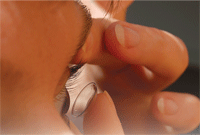 The Contact Lens Evaluation
The Contact Lens Evaluation
Once a practitioner determines the initial trial lens, he or she notates it in the patient’s record. To facilitate patient flow, they can present this information to a competent technician, who, in turn, locates the trial lens (or the most similar lens in parameters) in-office and places it onto the patient’s eye (see “Soft Contact Lens Insertion by the Practitioner”). While waiting for the lens to settle, practitioners move on to the next patient. Ideally, we must evaluate the fit after several hours because lens fits may tighten with time, but a minimum of 10 to 20 minutes of settling should suffice. This staggering of appointments also aids in patient flow. Of course, if a technician is unavailable, practitioners can locate and insert the lenses themselves.
During the fitting evaluation, a staff member should apply lenses for all new contact lens wearers. There are several reasons for this practice: first, a quick insertion expedites the examination and the schedule flow; second, because new patients are untrained, their attempts at insertion may cause trauma to the eyes; and last, an untrained patient’s insertion process could cause tearing, conjunctival chemosis or superficial punctate keratitis, which may, in turn, affect the appearance of the contact lens fit.
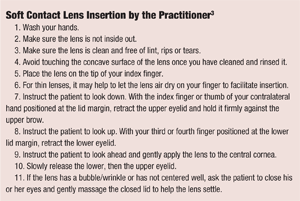 For experienced patients, I decide who inserts the lenses on a case-by-case basis. Some patients insist on inserting their own lenses. This is perfectly acceptable, perhaps even preferable; but for this option, a staff member must check on the patient in five to 10 minutes. When I return to the exam room to assess the lens fit, I want to see patients with lenses on their eyes, not still fumbling to get them in. When the latter scenario occurs, we have to insert the lenses for the patient and wait another 20 minutes, which can affect patient flow.
For experienced patients, I decide who inserts the lenses on a case-by-case basis. Some patients insist on inserting their own lenses. This is perfectly acceptable, perhaps even preferable; but for this option, a staff member must check on the patient in five to 10 minutes. When I return to the exam room to assess the lens fit, I want to see patients with lenses on their eyes, not still fumbling to get them in. When the latter scenario occurs, we have to insert the lenses for the patient and wait another 20 minutes, which can affect patient flow.
After the fit has been accessed, a competent staff member should always remove a new wearer’s lenses. For experienced wearers, either the patient or staff member may remove the lenses, depending on the patient and practice circumstances (see “Soft Contact Lens Removal by the Practitioner“).
The Dispensing Visit
The visit during which patients pick up their contact lenses is an important part of the contact lens fitting process. Whether it occurs on the day of the fitting or at a later date—with the doctor or ancillary staff member, in a dedicated “dispensing room” or elsewhere in the practice—this visit helps form the impressions your patient makes regarding contact lenses in general and your practice in particular. It also sets the stage for healthy habits regarding lens care and replacement both now and in the future.1
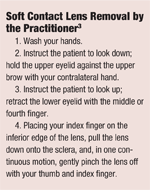 If a new contact lens wearer’s lenses are not dispensed during the initial fitting visit, the doctor or technician should insert the lenses. (Experienced wearers may insert their own lenses.) Allow the lenses to settle for at least 10 minutes, measure visual acuity and, if necessary, perform an over-refraction. Evaluate the lens fit and surface appearance. Contingent upon state law and technician competence, this appointment is often placed on the technician’s, rather than the doctor’s, schedule.2 In some states, the technician may perform all tests and call for the doctor to evaluate the lens fit only when necessary.
If a new contact lens wearer’s lenses are not dispensed during the initial fitting visit, the doctor or technician should insert the lenses. (Experienced wearers may insert their own lenses.) Allow the lenses to settle for at least 10 minutes, measure visual acuity and, if necessary, perform an over-refraction. Evaluate the lens fit and surface appearance. Contingent upon state law and technician competence, this appointment is often placed on the technician’s, rather than the doctor’s, schedule.2 In some states, the technician may perform all tests and call for the doctor to evaluate the lens fit only when necessary.
A typical appointment is allotted 30 to 45 minutes. The majority of this time is spent in contact lens care and insertion/removal training (see “Soft Contact Lens Insertion by the Patient” and “Soft Contact Lens Removal by the Patient”). It is important for patients to demonstrate competent lens application and removal before they are allowed to take their lenses home. If they are unable to accomplish this before the end of their appointment, then they must be rescheduled to another day. However, with today’s contact lens materials and designs, insertion and removal training is easier than ever, and the visit rarely exceeds its appointment time.
Lens Handling Tips
Before learning to insert and remove their lenses, new wearers must be proficient in handling them. They must first learn how to determine if a lens is inside-out. Rigid lenses almost always keep their proper orientation, but soft lenses can easily reverse, affecting fit, comfort and vision. The “profile inspection method” involves placing the lens, concave up, on the finger. When viewing the edge profile, a lens facing the correct way will look like a “bowl,” whereas an inside-out lens will have edges that “flare out.” If there is still a question of inversion, then patients can perform the “taco test.” When pinching the center of the lens gently between two fingers, a correctly orienting lens will have its edges folding toward each other, like a taco shell. If the edges turn out toward the fingers, then the lens is inverted.3
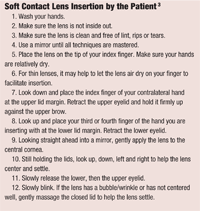 With today’s thinner, more comfortable lenses, it has become more difficult to ascertain lens eversion. Fortunately, many contact lens companies have devised “inversion indicators” to facilitate this task. Examples of such markers are “B+L” (Bausch + Lomb), “CIBA X6” and “OK” (CIBA Vision) and “123” (Vistakon). When a patient places the lens concave up on his index finger and views it from just underneath, a marker on a properly oriented lens will read correctly.3,4
With today’s thinner, more comfortable lenses, it has become more difficult to ascertain lens eversion. Fortunately, many contact lens companies have devised “inversion indicators” to facilitate this task. Examples of such markers are “B+L” (Bausch + Lomb), “CIBA X6” and “OK” (CIBA Vision) and “123” (Vistakon). When a patient places the lens concave up on his index finger and views it from just underneath, a marker on a properly oriented lens will read correctly.3,4
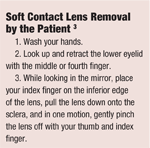 Follow-up Care
Follow-up Care
For subsequent follow-up care, including progress evaluations and complete eye examinations, we ask the patient to report to his examination with his lenses in place for at least four hours. It is important to view how the lenses fit mid-to-late day, as the maximum wearing time we have viewed up until this point is 30 minutes or less.
After lens fit evaluation and before biomicroscopy, contact lenses may be removed by the patient or staff member. Proponents of the latter consider it a service to the patient, stating that it maintains good hygiene and control of the examination. Many practices prefer one method over the other, and others decide on a case-by-case basis. Whatever a practice decides is acceptable.
Both patient and practice benefit from a successful contact lens-wearing experience, which starts with insertion and removal training. A positive attitude toward contact lenses on the part of both doctor and staff goes a long way in contributing to this success.

Inversion indicators such as Vistakon’s “123” help contact lens wearers determine how to properly insert their lenses.
1. Gromacki SJ. The contact lens dispensing visit, circa 2011. Cont Lens Spect. 2011 Apr;25(4):21.
2. Gromacki SJ. A good tech means good care. Cont Lens Spect. 2004 Oct;19(10):25.
3. Watanabe R, Gromacki SJ. Contact Lens Laboratory Manual. The New England College of Optometry. 1998:67-76.
4. Bitton E and Jones L. Don’t flip over inversion markers. Cont Lens Spect. 2011 Feb;25(2):51-2.

